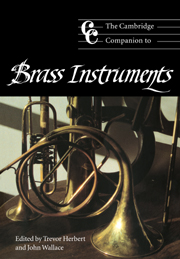Book contents
- Frontmatter
- Introduction
- 1 Lip-vibrated instruments of the ancient and non-western world
- 2 How brass instruments work
- 3 Design, technology and manufacture before 1800
- 4 Brass instruments in art music in the Middle Ages
- 5 The cornett
- 6 ‘Sackbut’: the early trombone
- 7 The trumpet before 1800
- 8 The horn in the Baroque and Classical periods
- 9 Design, technology and manufacture since 1800
- 10 Keyed brass
- 11 The low brass
- 12 Brass in the modern orchestra
- 13 Brass bands and other vernacular brass traditions
- 14 Playing, learning and teaching brass
- 15 The post-classical horn
- 16 Jazz, improvisation and brass
- 17 Brass solo and chamber music from 1800
- 18 Frontiers or byways? Brass instruments in avant-garde music
- Glossary
- Notes
- Select bibliography
- Index
16 - Jazz, improvisation and brass
Published online by Cambridge University Press: 28 September 2011
- Frontmatter
- Introduction
- 1 Lip-vibrated instruments of the ancient and non-western world
- 2 How brass instruments work
- 3 Design, technology and manufacture before 1800
- 4 Brass instruments in art music in the Middle Ages
- 5 The cornett
- 6 ‘Sackbut’: the early trombone
- 7 The trumpet before 1800
- 8 The horn in the Baroque and Classical periods
- 9 Design, technology and manufacture since 1800
- 10 Keyed brass
- 11 The low brass
- 12 Brass in the modern orchestra
- 13 Brass bands and other vernacular brass traditions
- 14 Playing, learning and teaching brass
- 15 The post-classical horn
- 16 Jazz, improvisation and brass
- 17 Brass solo and chamber music from 1800
- 18 Frontiers or byways? Brass instruments in avant-garde music
- Glossary
- Notes
- Select bibliography
- Index
Summary
In music, improvisation is a process in which a major portion of the resultant performance is not prearranged or anticipated. It is generated by the creator(s) during a performance. The degree to which improvisation is important varies between different musical styles, but in jazz it is virtually always central. The nature and definition of improvisation are complex issues which have been discussed in detail elsewhere. For the particularly technical purposes of the present book, it is noteworthy that improvisation commonly involves a redrawing of the assumed ground of a musical form, through instrumental technique, just as much as by musical vocabulary or structure. As John Corbett entertainingly puts it:
Old Pat Question: How does an improviser improvise?
New Pat Answer: By developing and employing a repertoire of possibilities in order to risk the unknown.
Jazz is a music of the twentieth century which originated in the USA from Afro-American traditions. It achieves improvised intensification by rhythmic repetition and cyclic harmonic repetition. Much jazz involves 4/4 metre, with considerable accentuation of the constituent pulses, and a vital concern with syncopation, of a subtle and complex kind. The syncopation is not simply displacing strong beats to their half-point or by whole beats, but also making irregular displacements, often in complex subdivisions of triplets and quintuplets, and accompanied by large, abrupt and transient variations in dynamic and/or emphasis: these are components of the special rhythmic ‘swing’ inherent in most jazz.
- Type
- Chapter
- Information
- The Cambridge Companion to Brass Instruments , pp. 217 - 235Publisher: Cambridge University PressPrint publication year: 1997



